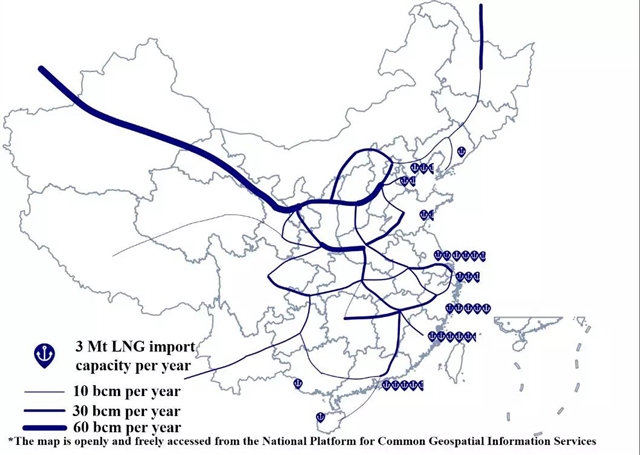|
|
|
|
|
我国能源转型阶段天然气系统建模及优化 | BMC Energy |
|
|
论文标题:Modelling and optimization of a natural gas supply system at a transient stage: a case study of China
期刊:BMC Energy
作者:Tianxiao Li, Pei Liu* and Zheng Li
发表时间:2019/06/25
数字识别码:10.1186/s42500-019-0005-6
原文链接:http://t.cn/Ai07xXh4
微信链接:https://mp.weixin.qq.com/s/gjzozqocLhcphcRkfY6oIg
天然气在我国能源系统的清洁低碳转型中具有重要地位。近年来,随着“煤改气”政策的大力推动,我国天然气消费量快速增长,对外依存度快速升高。2018年,我国天然气消费量达到2803亿立方米,对外依存度达到近45%。
我国天然气资源与需求在空间上分布不均,再加上天然气运输及存储极大依赖基础设施,我国已建成覆盖全国的天然气管网系统和遍及沿海各省的液化天然气接收站,从而对天然气进行跨区域的大规模调配,如图1所示。

图1 2017年我国跨省天然气管网及LNG接收站分布图
与此同时,我国天然气需求具有显著的季节性波动。冬季供暖使得天然气需求骤增,尤其是大力推广清洁供暖的华北地区。进口、运输和储存设施不足将难以应对天然气需求的季节性波动。2017年冬季,在多因素的作用下,我国出现了大范围的供气紧张现象。
未来,我国天然气需求仍将持续增长。根据国家发布的《能源发展“十三五”规划》和《能源生产与消费革命(2016-2030)》,天然气在我国一次能源消费比重将在2020年和2030年分别达到10%和15%,同时,我国天然气供应能力在2020年将达到3600亿立方米。
合理的天然气基础设施规划是满足不断增长的天然气需求及应对天然气需求季节性波动的关键。基础设施建设过早将带来投资浪费,而建设过晚又容易引发供应能力不足。我国国土面积广袤,区域差异显著,考虑到天然气基础设施建设的位置、容量和时间节点,使得规划问题更为复杂。
有鉴于此,来自于清华大学能源与动力工程研究团队近期发表在BMC Energy 上发表的文章Modelling and optimization of a natural gas supply system at a transient stage: a case study of China 建立了我国多区域天然气供应系统优化模型,在给定未来天然气需求的条件下,通过优化计算得到长期经济性最优的基础设施规划方案和天然气资源分配方案。模型将我国划分为30个区域,并以月份为时间步长以反映季节性差异,规划时间段覆盖2015到2050年。
本文依据该模型分析了四个问题。其一,模拟2017年冬季天然气供应紧张时天然气主干管网的运行情况。其二,在当前基础设施下,寻找能够降低成本的天然气资源配置方案。其三,根据基础设施建设规划,分析十三五规划中天然气消费目标实现的可能性。其四,在未来天然气需求预期下,天然气基础设施规划方案。主要结论如下:
一、2017年冬季天然气供应情况模拟如图2所示,结果显示西北向华北的输送通道均处于高负荷状态,北方沿海接收站也处于高负荷状态,一定程度上反映了当时的供气紧张局面。

图2 2017年12月我国主干天然气管网负荷模拟
二、在当前基础设施均处于高负荷运转的条件下,天然气资源供应方案优化空间较小。计算结果显示,将西北的天然气资源减少向华南供应,而增加向华北的供应,同时将LNG资源增加向华南的供应,减少向华北的供应,能够减少总体的运输成本。本研究采用的总经济成本最低的目标,是与天然气市场化定价的条件相匹配的,因为在市场化条件下,如果有使总成本降低的方案,总会有市场参与者采取适当行为通过降低成本获利。在当前不完全市场定价下,天然气资源分配方案和总成本最低的方案会产生一定偏差。
三、根据各省制定的“十三五”规划,2020年全国天然气需求将达到4080亿方,远超过国家总体基础设施规划和需求量预期。如果各省均按照各自规划推广天然气消纳,将导致严重的供应不足的局面。天然气供应能力的上下游是相互关联的,而各省分别制定各自“十三五”规划,导致了各省规划和国家规划相冲突的局面。
四、本文给出了我国天然气消费量在2020年、2035年和2050年分别达到3420、7780和8700亿方的情景下,天然气管网和LNG接收站的布局情况,包含地点、容量和时间节点等信息,如图3-5所示。储气库建设和投资信息可参考文章内容。

图3 2020年我国主干天然气管网和LNG接收站规划

图4 2035年我国主干天然气管网和LNG接收站规划

图5 2050年我国主干天然气管网和LNG接收站规划
摘要:
The global energy structure is on a low-carbon transition path featuring more natural gas consumption, and global natural gas demand has been increasing fast. Planning and operation of a natural gas supply system at a transient stage with multiple supply sources, end-consumers, and large infrastructure with multiple sub-systems are challenging tasks. Spatial and seasonal mismatch of natural gas supply and demand makes the natural gas distribution and infrastructure construction planning problem even more complex. Without proper planning, insufficient construction could lead to a shortage of natural gas supply, whilst excessive construction could lead to a higher cost. Quantitative analysis technologies are needed to facilitate decision-making during the transient stage of a natural gas system. In this work, we propose a monthly-scale multi-period and multi-regional modelling and optimization framework for planning and operation of a natural gas supply system at a transient stage, with a case study of the natural gas supply system in China. The optimal planning and operation strategy of the natural gas supply system in China by 2050 is obtained by minimizing the lifespan overall cost. Gaps between actual planning and the optimal planning are pointed out. Finally, policy suggestions are summarized, including establishing market-oriented pricing mechanisms, managing infrastructure centrally, promoting coordination amongst provinces when formulating projections, accelerating current infrastructure construction, and predicting natural gas demand and prices reasonably.
阅读论文全文请访问:
http://t.cn/Ai07xXh4
期刊介绍:
BMC Energy(https://bmcenergy.biomedcentral.com/) covers theory, development and applications in the interdisciplinary field of energy and fuel research from across the physical sciences, including engineering, physics, chemistry and the environmental sciences.
(来源:科学网)
特别声明:本文转载仅仅是出于传播信息的需要,并不意味着代表本网站观点或证实其内容的真实性;如其他媒体、网站或个人从本网站转载使用,须保留本网站注明的“来源”,并自负版权等法律责任;作者如果不希望被转载或者联系转载稿费等事宜,请与我们接洽。